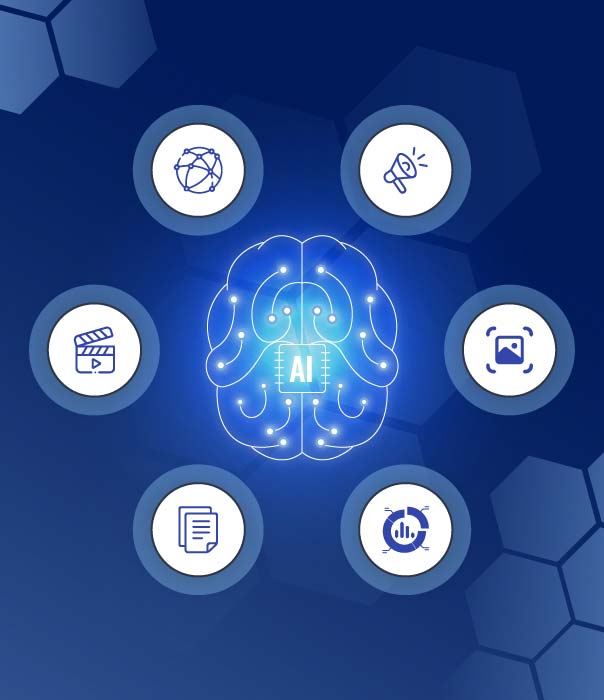Training AI models with unstructured, unlabeled multimodal data is complex and often lacks the accuracy required for high-performance outcomes. Our multimodal annotation services eliminate this challenge by delivering clean, structured and context-rich datasets across visual, audio, textual and sensor-based inputs.
We help AI teams annotate multimodal data with precision, whether it is bounding boxes with text, audio-synced video frames, or sensor fusion from LiDAR and radar. Our end-to-end multimodal data annotation workflows are designed for scale, speed and domain adaptability, making us the trusted partner for enterprises building computer vision, NLP, robotics, AR/VR, and healthcare AI models. We also offer flexible engagement models to meet evolving project demands and delivery timelines.
Our team of annotators, leverage human-in-the-loop technique, AI-assisted pipelines, QA systems, custom annotation tool integrations, and quality assurance checks at every stage. Backed by secure infrastructure and global delivery capability, we ensure you get high-quality, validated multimodal datasets, faster and without overheads. With HabileData, your AI training datasets are handled by top multimodal data annotation experts.
Start your multimodal annotation project today. »
Comprehensive solutions for accurate multimodal data annotation.
Label vision, audio and text data with bounding boxes, polygons and synced video-audio frames.
Deliver precision with 3D, temporal, medical and sensor fusion annotations for complex AI training.
Enable domain-specific models using sentiment, product, scene and AR/VR contextual annotations.
Enhance efficiency with schema design, tool setup, QA checks, and expert project coordination.

Gain instant access to trained teams experienced in handling complex, cross-modal annotation workflows.

Scale up quickly for high-volume projects with streamlined processes and faster delivery across modalities.

Reduce operational costs while maintaining high accuracy through dedicated QA and optimized workflows.

Leverage AI-assisted tools, secure environments, and custom integrations without upfront investment.

Free your internal teams to focus on model innovation while experts manage data annotation end-to-end.
Serving diverse industries with multimodal annotation precision
Multimodal annotation involves labeling data that comes from multiple sources or modalities such as text, images, video, audio, and sensor data, to provide context-rich information to AI models. This is crucial for training advanced models capable of understanding real-world scenarios where inputs are diverse and interconnected.
For example, autonomous vehicles interpret both visual and LiDAR data; healthcare systems may rely on image-text pairs. Multimodal annotation ensures these datasets are synchronized and structured, enabling AI systems to process, correlate, and reason across multiple data types with higher accuracy and contextual understanding.
We annotate a wide range of multimodal data, including image-text pairs (e.g., bounding box with description), audio-video synchronization (e.g., action detection with transcripts), 3D point clouds from LiDAR, sensor fusion data from radar and cameras, and medical imaging combinations like MRI and CT.
We also support sentiment-labeled social media content, AR/VR contextual scenes, and product tagging in e-commerce. Our services are adaptable to domain-specific requirements, be it robotics, autonomous vehicles, or medical diagnostics ensuring that each modality is aligned and annotated for optimal AI training and real-world performance.
We ensure annotation accuracy through a multi-layered quality control process that includes expert review, automated consistency checks, and domain-specific guidelines.
Every project begins with a well-defined annotation schema, followed by continuous training and calibration of annotators. Our QA teams conduct spot checks and full reviews on random samples, while feedback loops refine results in real time. For complex tasks like sensor fusion or medical annotation, we use domain experts and cross-validation. This rigorous process guarantees high precision, reduces label ambiguity, and supports the consistent performance of your AI models.
We leverage both proprietary and third-party tools customized to support multimodal inputs. These include platforms that enable synchronized annotation across audio, video, text, and 3D sensor data.
For example, tools like CVAT, Labelbox, VGG Image Annotator, and Pointly are used in combination with custom-built workflows and plug-ins. We also integrate automated annotation features powered by AI to speed up repetitive tasks while maintaining human-in-the-loop oversight for critical accuracy. Tool selection is guided by your project’s complexity, volume, and integration needs, ensuring scalability, data security, and seamless collaboration.
Yes, we offer fully customizable annotation workflows tailored to your AI model’s requirements. This begins with understanding your use case, dataset structure, and model objectives. We then define the annotation schema, choose the right tools, and assign domain-trained annotators accordingly.
Whether you need class-specific labeling, attribute tagging, audio transcription, or sensor fusion alignment, we adapt our process to ensure the labeled data feeds seamlessly into your model training pipeline. We also support iterations, validation runs, and updates based on model feedback to improve training outcomes continuously.
We prioritize data security and privacy at every stage. Our infrastructure is built on secure cloud environments with restricted access controls, encryption in transit and at rest, and role-based permissions.
We are compliant with major data protection regulations such as GDPR, HIPAA (for healthcare projects), and CCPA. NDAs are signed with all employees and contractors, and we implement regular audits and monitoring to detect any anomalies. For sensitive data, we also offer on-premise or VPN-restricted workflows. Client data confidentiality is a core principle in all our multimodal annotation engagements.
Our multimodal annotation services help accelerate your AI development by delivering clean, context-rich, and precisely labeled datasets. We offer scalable teams, domain expertise, QA-led workflows, and tool customization to suit any project.
Whether you’re building a healthcare diagnostic model or a self-driving car system, we ensure that your model gets high-quality training data from synchronized sources. This reduces rework, improves model performance, and speeds up time-to-market. By outsourcing to us, you reduce internal overhead and gain access to best-in-class infrastructure and expert project management.
Multimodal annotation enhances AI model performance by supplying data that mirrors real-world complexity. When different data types like text, images, video, and sensors are annotated in a synchronized, structured way, models learn to make deeper connections and more accurate predictions.
For instance, a retail model may improve product recognition when trained on images with matching descriptions and voice inputs. Likewise, autonomous systems perform better when combining LiDAR and visual inputs. Accurate multimodal data helps reduce bias, handle edge cases better, and ultimately improve the generalizability of your AI system.
Turnaround time depends on dataset size, complexity, and number of modalities involved. For standard projects, we typically deliver initial batches within a few days and full datasets within 1 to 4 weeks.
For large-scale or high-complexity tasks like 3D point cloud segmentation or medical image fusion, timelines are agreed upon after a detailed assessment. Our scalable workforce, global delivery centers, and optimized workflows allow us to ramp up quickly and meet tight deadlines without compromising quality. We also offer milestone-based deliveries to support your iterative model development cycle.

















